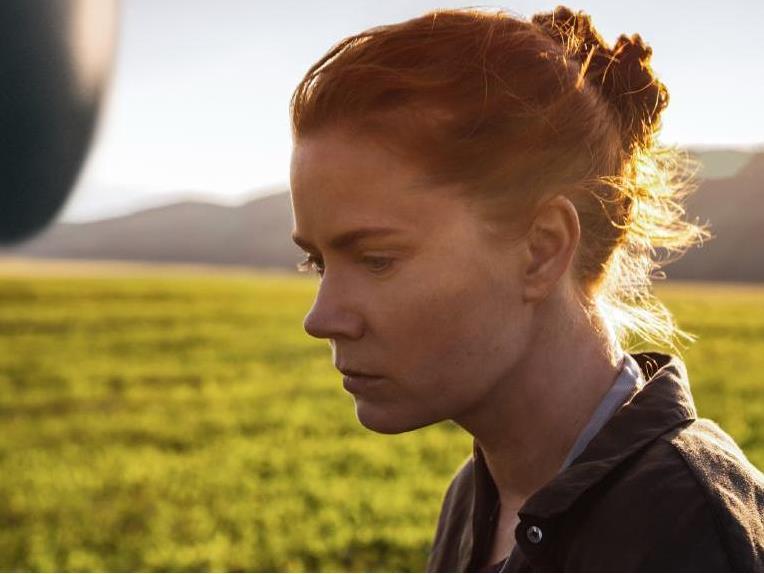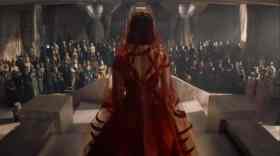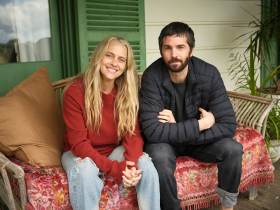Amy Adams as Louise Banks in Arrivals. Image via Roadshow Entertainment.
Lines, curves, shapes, architecture, geometric patterns: they’re impossible to avoid as Arrival starts to unravel its science fiction story. The film’s protagonist, linguistics professor Louise Banks (Amy Adams, Nocturnal Animals) speaks of memories and important moments as the opening narration sets the scene; however the movie’s imagery places her within defining features of another kind. She works with language and symbols, ruminates over thoughts and emotions, and frequently stands looking over the markers of our physical world. When all three converge in the form of her visit to one of the twelve oval, vertical spaceships that have suddenly started hovering in random spots around the globe, director Denis Villeneuve (Sicario) and writer (Lights Out’s Eric Heisserer, adapting Ted Chiang’s novella Story of Your Life) couldn’t make it feel like a more natural development.
Arrival is sci-fi of the big-thinking yet grounded kind – and of the big-feeling, sweeping type as well. It charts the aftermath of what is feared to be an alien invasion. It scurries through the massive US military operation set up in Montana in response, as overseen by the somewhat open-minded Colonel Weber (Forest Whitaker, Southpaw) and more aggressive CIA Agent Halpern (Michael Stuhlbarg, Doctor Strange). It depicts the international battle being waged between other countries uncertain how to handle their own arrival sites, with Chinese General Shang (Tzi Ma, TV’s Veep) seemingly trigger-happy. But, that’s all context and dramatic impetus. The real focus of the film falls upon Louise’s efforts to learn the language of and communicate with two seven-legged, spider-esque creatures alongside theoretical physicist Ian Donnelly (Jeremy Renner, Captain America: Civil War), all while shaken by grief for a long-absent husband and a cancer-inflicted daughter.
Here, fear and reticence combine with curiosity and investigation, and the act of reaching out to others, and into the universe, with the process of looking inwards. Accordingly, as Louise cycles through days of snatching sleep where she can, climbing into a fluorescent orange suit, defying gravity upon entering the alien vessel and speaking to the visitors via a whiteboard, fragments of her time away from this brave new realm are weaved into the narrative. As well as offering a counterpoint to the immersive mechanics of her significant task, it demonstrates Arrival’s intelligent approach to interacting with extra-terrestrial life. With the usual gunfights, toppled cities, and other displays of might well and truly nonexistent, the feature smartly recognises that such an encounter doesn’t just alter the external environment that cinematographer Bradford Young (Selma) lenses with soothing, never chilly, grey tones. It also has a profound internal impact upon everyone involved.
Many other offerings in the genre have flirted with the same feat, spanning Close Encounters of the Third Kind, Contact, and Interstellar, to name a few. The inquisitive searching of the first, the personal longing of the second, and the sentiment of the third are all be present here in fits and spurts, and yet Arrival remains its own unexpected entity. It oozes a distinctive mood and tone, not just through Villeneuve and Heisserer’s preference for contemplation over conflict, and the director and Young’s evident visual precision, but also through a score by the filmmaker’s regular composer Jóhann Jóhannsson (Sicario, Prisoners) that manages to evoke unease and radiate comfort all at once. And, the movie has an innate sense of just how long its tale should take to play out, with editor Joe Walker (Blackhat) making each one of its 116 minutes fly by, and count.
First and foremost, though, Arrival is gripping not only because of the ideas at play, or how they’re conveyed via its stylistic choices, but how they rest on the shoulders of Adams. In a restrained leading effort, hers is a performance that earns that term in the way she navigates the weighty matters at play – never simplifying or needlessly rationalising Banks’ reactions – while proving the opposite in impact. It’s a thoughtful, sensitive portrayal designed to connect and to challenge at the same time. In a film that uses otherworldly entities, the ability to converse with them, and their interplay with love, loss, time, space and existence, it’s also exactly what’s needed to bridge the gap between the feature’s intriguing science fiction premise and resonant philosophical journey.
Rating: 4 ½ stars out of 5
Arrival
Director: Denis Villeneuve
USA, 2016, 116 mins
Release date: 10 November
Distributor: Roadshow
Rated: M
Actors:
Director:
Format:
Country:
Release:





